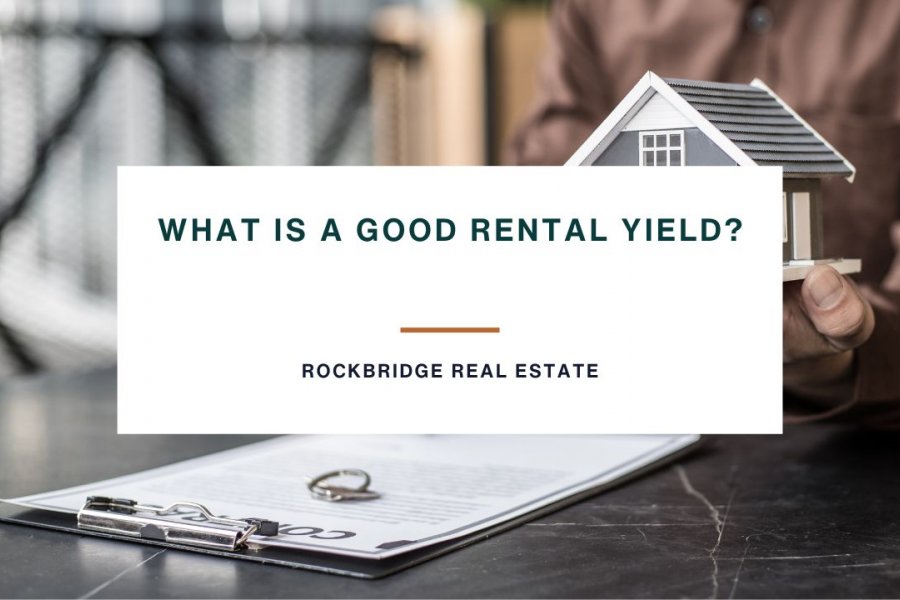
Renting out a property is a simple way to grow your wealth over time and create a passive source of income. Additionally, multiple properties have added benefits, such as tax deductions and a hedge against inflation. This is why more and more investors are now choosing to invest in real estate over the stock market.
Despite the ample benefits, rental investments don’t come without risks. For instance, landlords risk a negative cash flow if their mortgage payments, maintenance and operating expenses surpass their monthly rental yields.
It’s crucial that you know how to choose the right rental property for your investment goals. This includes knowing how to determine your net operating income.
In this article, the experts at Rockbridge Real Estate will go over everything real estate investors should know about total rental yield. If you want to learn how to when to use rental yields and how to calculate it, we’ve got you covered!
Understanding What Gross Yield Is
The gross rental yield is the total amount of money real estate investors earn from a rental property in a year before tax and expense deductions. This percentage is obtained by dividing the property’s annual rental yields by its purchase price or market value.
Typically, the higher the percentage, the better. However, aiming for a total rental yield around the seven or eight percent mark is a good place to start.
Calculating your total rental yields is a simple and reliable way to measure the return on your investment. However, it’s important to note that this is only one of many factors you should consider before investing in a rental property.

After all, the gross yield calculation doesn’t include the many expenses a rental property owner has, such as tax rates, maintenance and repairs, advertising, insurance, and more. So, don’t be swayed by a high percentage, and make sure you consider the cost of operation and other expenses before purchasing a rental property.
Why Calculate the Gross Yield of Your Rental Property?
Calculating the net rental yields of a rental property has many benefits, including:
• Assessing the potential profitability of your investment. Calculating the net rental yield gives you an idea of how much money you can make off a property. Although this doesn’t include the money you’ll have to spend on property taxes and other expenses.
• Comparing different rental properties. If you’re trying to choose between two or more rental properties, calculating the gross rental yield of each property can significantly help you determine which offers a better return on investment.
• Setting accurate rent prices. Understanding the potential income relative to the property's cost can help you avoid overpricing or underpricing your rental property. An accurate rent price is essential.
• Saving time and effort. The gross rental yield can help you filter out properties that don’t meet your investment goals, saving you valuable time and effort.
Additionally, it's relatively quick and straightforward to calculate gross rental yield. Real estate investors can do the calculation in their head or with a calculator in a matter of seconds!
How to Calculate Your Rental Property’s Gross Yield
Real estate investors calculate rental yield for more than real estate related matters. You can use it for any assets that generate an annual rent income.
For the gross rental yield calculation, you’ll need to calculate the annual rent income first. This can be easily done by multiplying the current rent price by 12. It’s also important to know the property's current market value.
.jpg)
If you don’t know the current market value for your rental property, you can use the purchase price instead, but make sure to consider expenses such as choosing fees, renovations, and insurance. This is why knowing whether you're financing or buying it in cash is important.
Then, to calculate the gross rental yield, you must divide the annual income by the property value. You’ll be left with a decimal number that you can turn into a percentage. For instance, if you divide a $5,000 gross rental income by a $100,000 home value, you’ll get 0.05, meaning you have a 5 percent gross rental yield.
Why Does My Rental Property’s Gross Yield Fluctuate?
Your rental gross yield for your property will fluctuate over time. After all, this is a common occurrence in the real estate industry. The main factors that can make your gross rental yield go up or down are:
• Market fluctuations. Your gross yield can fluctuate as the real estate market changes. For instance, if a property value goes up, your gross yield will likely increase.
• New or increased expenses. Fluctuations in operating costs, such as taxes, maintenance, and insurance, can significantly influence your gross yield. After all, if you’re making the same annual rental income, but your expenses increase your property’s profitability will decrease.
• Increased vacancy rates. Frequent tenant turnover or extended property vacancies lower your annual rental income, reducing your gross yield. That’s why consistent occupancy is crucial for maintaining and increasing your ROI.
• Rent increases. Charging higher rent in response to market trends can significantly increase your gross yield. However, charging an extremely high rent, while increasing immeidate cash flow, can scare tenants away, negatively impacting your net rental yield.
• Renovations and improvements. Investing in upgrades or renovations for your rental property can significantly increase its value and rental income. This can potentially improve your rental gross yield of your property.
• Economic factors. Economic factors, such as inflation or interest rate fluctuations, can affect both investment property values and rental income. This, in turn, can affect your gross yield.
.jpg)
While you can’t control market trends and economic factors, you can still do many things to increase your rental gross yield.
For instance, you can assess your current rent price to ensure it’s not below the market rate, or you can invest in renovations or upgrades that will increase the value of your property. Another thing you can do is implement a thorough screening process to minimize the risk of evictions, tenant turnover, and property vacancies.
Bottom Line
Calculating the rental gross yield helps you assess the potential profitability of a real estate investment. Although it doesn’t give you an entire picture of how a rental property will perform, this calculation can still be used to set the rent price or choose between two different properties.
Now that you know how to calculate a rental gross yield of your property, you’re better prepared to make a sound rental investment!
Are you looking to invest in a Missouri rental property with high rental yield? Contact Rockbridge Real Estate! When you hire our property management company, we eliminate all the stress and headaches that come with being a real estate investor. We’ll help you find a profitable property investment with little to no effort and take care of your tenants needs!